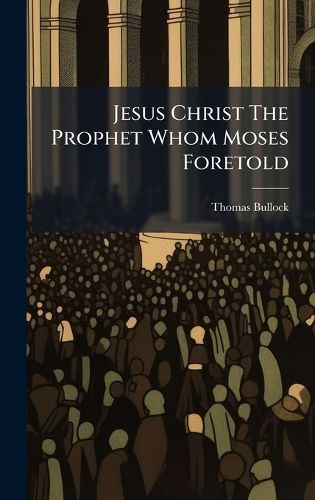Readings Newsletter
Become a Readings Member to make your shopping experience even easier.
Sign in or sign up for free!
You’re not far away from qualifying for FREE standard shipping within Australia
You’ve qualified for FREE standard shipping within Australia
The cart is loading…






Jesus Christ The Prophet Whom Moses Foretold is a carefully transcribed sermon delivered by Thomas Bullock at the Cathedral-Church of Norwich on June 28th, 1724. This historic sermon explores the prophetic relationship between Moses and Jesus Christ, delving into theological interpretations relevant to the early 18th century. Bullock's discourse offers insights into the religious thought of the period, further enriched by a postscript clarifying a passage from St. Paul's Epistle to the Galatians. This work provides valuable perspectives for scholars and readers interested in religious history, sermon studies, and the theological debates of the era. The enduring relevance of Bullock's exploration makes this a compelling read for those seeking to understand the historical interpretation of biblical prophecy.
This work has been selected by scholars as being culturally important, and is part of the knowledge base of civilization as we know it. This work was reproduced from the original artifact, and remains as true to the original work as possible. Therefore, you will see the original copyright references, library stamps (as most of these works have been housed in our most important libraries around the world), and other notations in the work.
This work is in the public domain in the United States of America, and possibly other nations. Within the United States, you may freely copy and distribute this work, as no entity (individual or corporate) has a copyright on the body of the work.
As a reproduction of a historical artifact, this work may contain missing or blurred pages, poor pictures, errant marks, etc. Scholars believe, and we concur, that this work is important enough to be preserved, reproduced, and made generally available to the public. We appreciate your support of the preservation process, and thank you for being an important part of keeping this knowledge alive and relevant.
$9.00 standard shipping within Australia
FREE standard shipping within Australia for orders over $100.00
Express & International shipping calculated at checkout
Jesus Christ The Prophet Whom Moses Foretold is a carefully transcribed sermon delivered by Thomas Bullock at the Cathedral-Church of Norwich on June 28th, 1724. This historic sermon explores the prophetic relationship between Moses and Jesus Christ, delving into theological interpretations relevant to the early 18th century. Bullock's discourse offers insights into the religious thought of the period, further enriched by a postscript clarifying a passage from St. Paul's Epistle to the Galatians. This work provides valuable perspectives for scholars and readers interested in religious history, sermon studies, and the theological debates of the era. The enduring relevance of Bullock's exploration makes this a compelling read for those seeking to understand the historical interpretation of biblical prophecy.
This work has been selected by scholars as being culturally important, and is part of the knowledge base of civilization as we know it. This work was reproduced from the original artifact, and remains as true to the original work as possible. Therefore, you will see the original copyright references, library stamps (as most of these works have been housed in our most important libraries around the world), and other notations in the work.
This work is in the public domain in the United States of America, and possibly other nations. Within the United States, you may freely copy and distribute this work, as no entity (individual or corporate) has a copyright on the body of the work.
As a reproduction of a historical artifact, this work may contain missing or blurred pages, poor pictures, errant marks, etc. Scholars believe, and we concur, that this work is important enough to be preserved, reproduced, and made generally available to the public. We appreciate your support of the preservation process, and thank you for being an important part of keeping this knowledge alive and relevant.